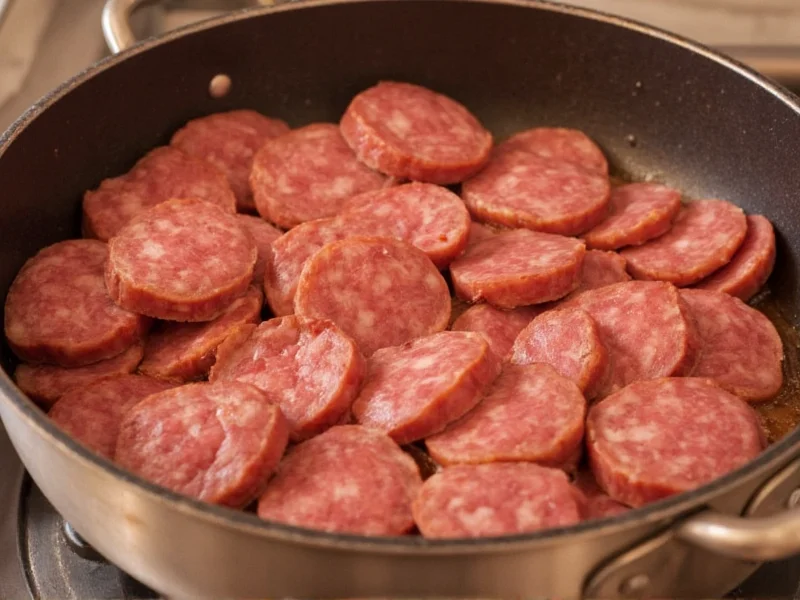Understanding proper internal temperatures for sausages isn't just about culinary perfection—it's a critical food safety practice. Many home cooks rely on color or cooking time to determine doneness, but these methods can be dangerously misleading. The only reliable way to ensure your sausage is safe to eat is by using a food thermometer to verify it has reached the appropriate internal temperature.
Why Temperature Matters More Than Appearance
Sausages often retain a pink color even when fully cooked due to ingredients like nitrites used in curing. This persistent pink hue frequently causes confusion, leading many to undercook their sausages. The USDA Food Safety and Inspection Service emphasizes that color alone cannot indicate whether meat has reached a safe temperature.
Undercooked sausage poses significant health risks. Fresh sausages made from ground meat can harbor harmful bacteria including Salmonella, E. coli, and Trichinella spiralis. These pathogens only die at specific temperatures, making accurate temperature measurement essential for food safety.
Sausage Temperature Guidelines by Type
| Sausage Type | Safe Internal Temperature | Special Considerations |
|---|---|---|
| Pork, Beef, Lamb Sausages | 160°F (71°C) | Ground meat requires higher temperature than whole cuts |
| Chicken, Turkey Sausages | 165°F (74°C) | Poultry requires higher temperature due to Salmonella risk |
| Pre-cooked Sausages | 140°F (60°C) | Only requires reheating to serving temperature |
| Smoked Sausages | 140°F (60°C) | Check packaging; many are fully cooked |
How to Accurately Measure Sausage Temperature
Proper thermometer technique makes all the difference when checking your sausage's internal temperature. Follow these steps for accurate readings:
- Choose the right thermometer - Digital instant-read thermometers provide the most accurate sausage temperature readings. Avoid dial thermometers for thin sausages.
- Insert correctly - Place the probe into the thickest part of the sausage, avoiding the casing and any bones.
- Check multiple sausages - Don't assume all sausages in a batch reach the same temperature.
- Wait for stabilization - Keep the thermometer in place until the reading stops changing (usually 10-15 seconds).
- Clean between uses - Sanitize your thermometer between measurements to prevent cross-contamination.
Common Temperature Measurement Mistakes
Even experienced cooks make these critical errors when checking sausage temperatures:
- Testing too early - Checking temperature before the sausage has had time to reach thermal equilibrium
- Measuring near the casing - The casing heats faster than the interior, giving false high readings
- Not checking the center - The thickest part is always the last to cook through
- Using visual cues - Relying on color or juice clarity instead of actual temperature
- Not calibrating thermometers - An uncalibrated thermometer can be off by 5-10 degrees
Additional Food Safety Practices for Sausage Preparation
Temperature measurement is just one component of safe sausage handling. Implement these additional practices:
Always keep raw sausages separate from ready-to-eat foods to prevent cross-contamination. Store sausages at 40°F (4°C) or below, and cook within 1-2 days of purchase for fresh varieties. When grilling, avoid pressing down on sausages with utensils, as this forces out juices and can cause flare-ups that char the exterior while the interior remains undercooked.
After reaching the proper internal temperature, allow sausages to rest for 3-5 minutes before serving. This resting period allows heat to distribute evenly throughout the sausage and completes the cooking process. Remember that carryover cooking can raise the internal temperature by 5-10 degrees after removal from heat.
Special Considerations for Different Cooking Methods
The cooking method affects how evenly your sausage heats and how you should monitor temperature:
- Grilling - Check temperature on the side opposite the grill grates to avoid false readings from direct heat
- Pan-frying - Rotate sausages occasionally for even cooking before taking temperature
- Baking - Use an oven-safe thermometer for continuous monitoring
- Smoking - Monitor temperature closely as low-and-slow cooking takes longer to reach safe temperatures
When cooking sausages from frozen, add approximately 50% more cooking time and check temperature carefully, as frozen centers can remain undercooked even when the exterior appears done.
Trusting Your Thermometer: Calibration Matters
An inaccurate thermometer defeats the purpose of temperature monitoring. Calibrate your thermometer monthly using either the ice water method (should read 32°F/0°C) or boiling water method (should read 212°F/100°C at sea level). Digital thermometers often have a calibration function, while dial thermometers may require adjustment with a nut at the base.
For the most reliable results when checking the internal temp for sausage, invest in a high-quality instant-read thermometer with a thin probe that can accurately measure the narrow diameter of most sausages. Look for models specifically designed for thin foods with quick response times.











 浙公网安备
33010002000092号
浙公网安备
33010002000092号 浙B2-20120091-4
浙B2-20120091-4